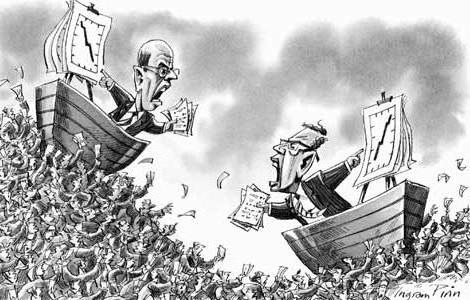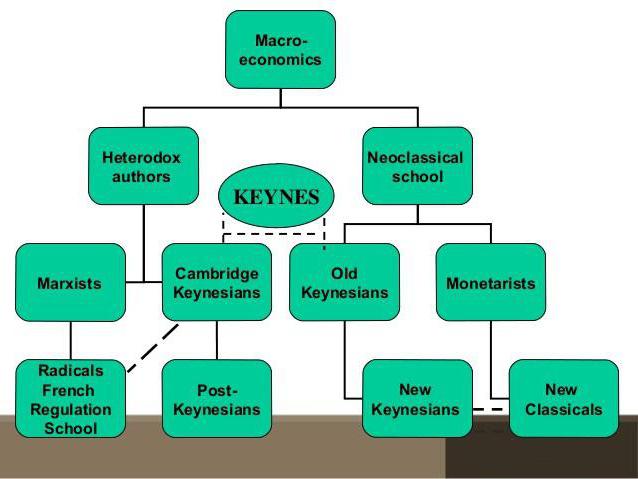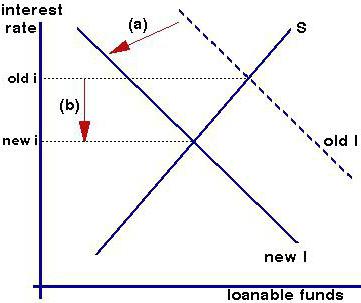Keynesianism is a collection of different theories about how an aggregate demand indicator (consumption of all entities) has a strong impact on production in the short term, especially during recessions. The origin of this school is associated with the name of the famous British economist. In 1936, John Maynard Keynes published his work, The General Theory of Employment, Interest, and Money. In it, he contrasted his teachings with the classic proposal-oriented approach to the regulation of the national economy, this approach was almost immediately applied in practice. Today Keynesianism is not just one school, but several currents, each with its own characteristics.

general characteristics
Representatives of the Keynesian approach consider aggregated (aggregate) supply as an indicator that is equivalent to the production capacity of the economy. They believe that many factors influence it. therefore aggregate demand can rise and fall randomly, affecting overall output, employment and inflation. This approach to the national economy was first applied by the British economist John Maynard Keynes. The dominant proposal-oriented ideas at that time did not meet the needs of the time, being unable to solve the problem of the consequences of the Great Depression.
Theory features
Keynesianism is a direction that advocates active government intervention in the economy. Its representatives believe that decisions in the private sector are the cause of inefficiencies in the national economy. Therefore, the only "cure" is an active monetary and fiscal policy by the central bank and the government. The stabilization of business activity cycles depends on the latter. Keynesians favor a mixed economy. The advantage is given to the private sector, but during recessions the state actively intervenes in the national economy.

Historical context
Keynesianism in the economies of developed countries was the standard model at the end of the Great Depression, during World War II and in the period of post-war growth (1945-1973). However, it has lost its dominant position after energy crises and stagflation in the 1970s. Currently, we can observe a repeated increase in interest in this area. This is due to the inability of classic market models to cope with the consequences of the financial crisis of 2007-2008. New Keynesianism is a school that assumes the rationality of the expectations of households and firms, as well as the existence of market failures, to overcome which state intervention is necessary. We will dwell on the features at the end of this article.
Keynesianism: representatives
Many scientists adhered to the views of this economic school. Among them:
- John Maynard Keynes (1883-1946);
- Joan Robinson (1903-1983);
- Richard Caan (1905-1989);
- Piero Sraffa (1898-1983);
- Austin Robinson (1897-1993);
- James Edward Mead (1907-1995);
- Roy F. Harrod (1900-1978);
- Nicholas Caldor (1908-1986);
- Michal Kaleki (1899-1970);
- Richard M. Goodwin (1913-1996);
- John Hicks (1904-1989);
- Paul Krugman (1953 -).

Scientist's contribution to science
The School of Economics, which advocates government intervention in the national economy, especially during recessions, is named for its founder and chief apologist. The ideas presented by John Maynard Keynes changed the theory and practice of modern science.He developed his theory of the causes of cyclicality, and is considered one of the most influential economists of the 20th century and the present. Keynesianism in the economy was a real revolution, because it dared to refute the classic ideas of the "invisible hand" of the market, which can independently solve any problems. In 1939-1979, the views of this economic school dominated in developed countries. It was on them that the policy of their national governments was based. However, only after the Second World War, it was possible to take a sufficient number of loans to eliminate unemployment. According to John Kenneth Gelbraith, who was responsible for controlling inflation in the United States during this period, it was difficult to find another more successful period for demonstrating the possibilities of applying Keynesianism in practice. Keynes's ideas were so popular that he was called the new Adam Smith and the founder of modern liberalism. After World War II, Winston Churchill tried to build his campaign on criticism of this trend and lost to Clement Attlee. The latter just advocated an economic policy based on Keynes's ideas.

Concept
Keynesian theory deals with five issues:
- Salaries and expenses.
- Excessive Savings.
- Active fiscal policy.
- Multiplier and interest rates.
- Investment Savings Model (IS-LM).
Keynes believed that to solve the problems associated with the Great Depression, it is necessary to stimulate the economy (encourage investment) by using a combination of two approaches:
- Interest rate reduction. That is, the application of elements of monetary policy by the central bank of the country (US Federal Reserve).
- Government investment in the creation and provision of infrastructure. That is, through an artificial increase in demand due to government spending (fiscal policy).

"General theory of employment, interest and money"
This most famous Keynes theory was published in February 1936. She is considered key work in the field of economics. The “General Theory of Employment, Interest, and Money” laid the foundation for terminology and formed the modern theory. It consists of six parts and a preface. The main idea of this work is that employment is determined not by the price of labor as a factor of production, but by expenditure of money (aggregate demand). According to Keynes, the assumption that competition in the market in the long run will lead to full employment, since the latter is an indispensable attribute of the equilibrium state, which is established if the state does not intervene in the economy and everything goes as it should, is wrong. On the contrary, he believed that unemployment and lack of investment - this is in the order of things in the absence of competent government management. Even lower salaries and increased competition do not bring the desired effect. Therefore, Keynes in his book advocates the need for state intervention. He even admits that the Great Depression could have been prevented if at that time everything had not been left to the mercy of a free and competitive market.

Modern Keynesianism
After the global financial crisis, there has been a repeated increase in interest in this area. New Keynesianism, whose representatives are increasingly strengthening their positions in the economic community, appeared in the late 1970s. They insist on the existence of market failures and impossibility perfect competition. Therefore, the price of labor as a factor of production is inflexible. Therefore, it cannot immediately adapt to changes in market conditions. Thus, without government intervention, a state of full employment is unattainable. According to representatives of the new Keynesianism, only the actions of the state (fiscal and monetary policies) can lead to efficient production, and not the laissez faire principle.








